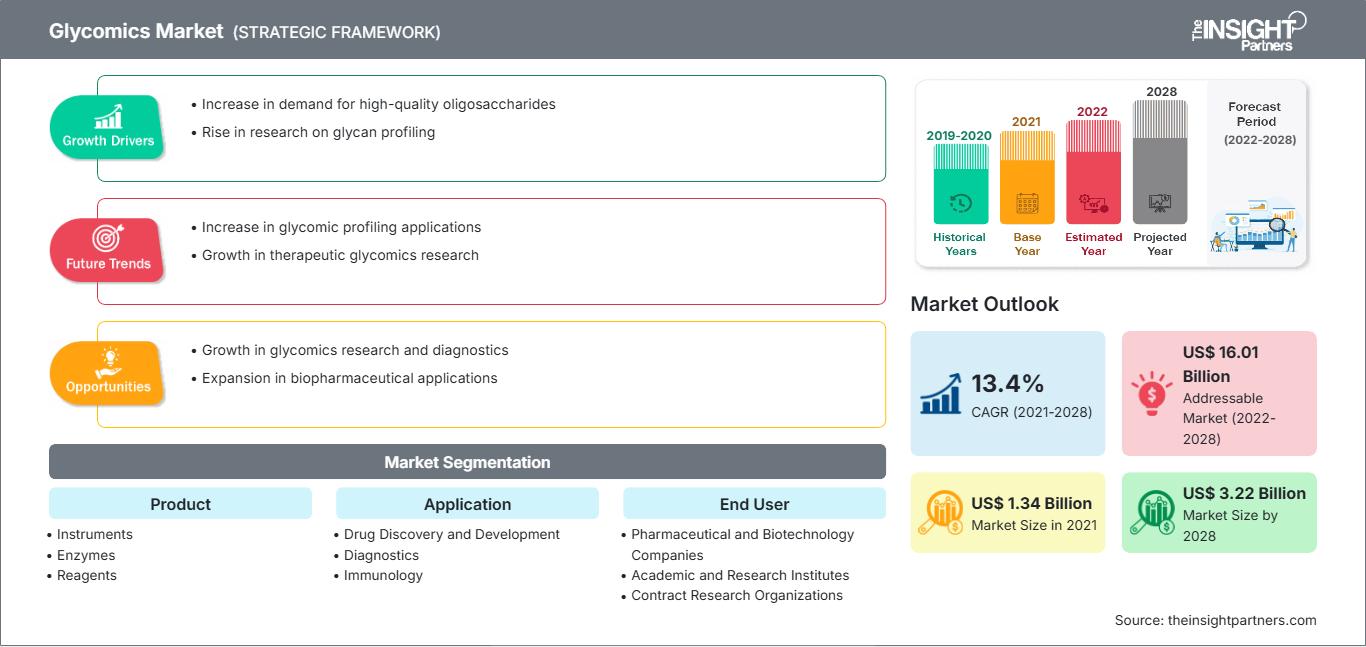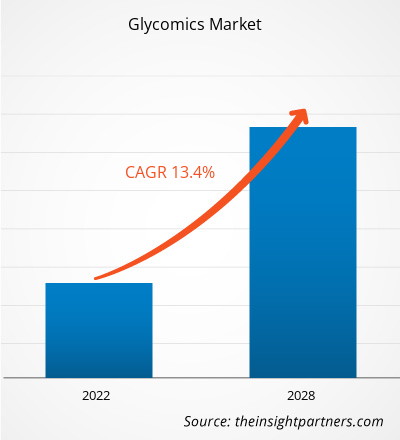[Informe de investigación] Se prevé que el mercado de la glicómica crezca de 1.340,80 millones de dólares estadounidenses en 2021 a 3.223,30 millones de dólares estadounidenses en 2028; se estima que crecerá a una tasa de crecimiento anual compuesta (TCAC) del 13,4% entre 2022 y 2028.
Los glicanos son responsables de gran parte de la variación estructural en los sistemas biológicos, y su representación en las superficies celulares se conoce comúnmente como " glicoma ". La glicómica es un campo emergente que se centra en la estructura y función de los glicanos en células, tejidos u organismos. Los glicanos son estructuras de carbohidratos en forma de cadena, libres o conjugadas a macromoléculas como lípidos o proteínas. Contribuyen a diversos procesos biológicos, como el plegamiento de proteínas, la señalización celular y el reconocimiento inmunitario. Estos procesos están implicados en varias enfermedades, como las oncológicas , las autoinmunes y otras. El mercado de la glicómica está impulsado por el aumento de la investigación en este campo, el incremento de las inversiones en I+D y su uso para tratar diversas enfermedades, lo que conlleva el desarrollo de nuevos tratamientos. Sin embargo, el elevado coste de los equipos y la escasez de profesionales cualificados dificultan el crecimiento general del mercado.
El informe ofrece información y un análisis exhaustivo del mercado de la glicómica , haciendo hincapié en diversos parámetros como las tendencias del mercado, los avances tecnológicos, la dinámica del mercado y el análisis del panorama competitivo de los principales actores del mercado global. También incluye el impacto de la pandemia de COVID-19 en el mercado en todas las regiones. Debido a la pandemia, muchas autoridades sanitarias se centraron en la atención relacionada con la pandemia. Recientemente, nuevos estudios sobre el coronavirus han revelado mecanismos de infección que dependen del uso de glicanos humanos por parte del virus . Por ejemplo, los investigadores de GlycoNet demostraron que el virus de la COVID-19 entra en las células uniéndose a glicolípidos . Actualmente, los investigadores están analizando si las variantes de la COVID-19 que generan preocupación están modificando sus propiedades de unión a glicanos . Por lo tanto, la pandemia de COVID-19 tuvo un impacto positivo en el mercado de la glicómica debido al aumento de la investigación a nivel mundial.
Obtendrá personalización gratuita de cualquier informe, incluyendo partes de este informe, análisis a nivel de país y paquetes de datos de Excel. Además, podrá aprovechar excelentes ofertas y descuentos para empresas emergentes y universidades.
Mercado de la glicómica : Perspectivas estratégicas

-
Obtenga las principales tendencias clave del mercado que se describen en este informe.Esta muestra GRATUITA incluirá análisis de datos, desde tendencias del mercado hasta estimaciones y pronósticos.
Perspectivas basadas en la geografía
Geográficamente, el mercado de la glicómica se segmenta en Norteamérica (EE. UU., Canadá y México), Europa (Francia, Alemania, Reino Unido, España, Italia y el resto de Europa), Asia Pacífico (China, India, Japón, Australia, Corea del Sur y el resto de Asia Pacífico ), Oriente Medio y África (Arabia Saudita, Emiratos Árabes Unidos , Sudáfrica y el resto de Oriente Medio y África ) y Sudamérica y Centroamérica (Brasil, Argentina y el resto de Sudamérica y Centroamérica).
Perspectivas del mercado
El creciente uso de la glicómica en diversas enfermedades conduce al desarrollo de nuevos procesos de tratamiento.
A medida que los científicos han concentrado sus esfuerzos en el campo de la glicómica , han comenzado a descubrir detalles importantes sobre las funciones de los glicanos y la glicosilación en el organismo, incluyendo la comunicación celular y lo que estos factores podrían revelar sobre el desarrollo y el diagnóstico de enfermedades. La categoría de aplicación más grande y de mayor crecimiento es el descubrimiento y desarrollo de fármacos, principalmente debido al aumento de la I+D por parte de las empresas farmacéuticas y biotecnológicas y a la expansión de las actividades de investigación en descubrimiento de fármacos en instituciones de investigación universitarias. Por ejemplo, en abril de 2020, para comercializar una herramienta de detección de cáncer de vanguardia, investigadores del Instituto de Glicómica y la Universidad de Adelaida firmaron un acuerdo de licencia exclusiva con Sienna Cancer Diagnostics Ltd. Estos investigadores han creado una proteína especial llamada SubB2M, que se une exclusivamente a una molécula de azúcar presente únicamente en las células cancerosas. Esta proteína podría revolucionar la detección del cáncer. Además, en enero de 2022, el Consejo Nacional de Investigación Médica y de Salud ( NHMRC ) otorgó a investigadores del Instituto de Glicómica subvenciones por un total de más de 1.100.000 dólares estadounidenses para ayudarlos a crear nuevos medicamentos para tratar las infecciones de gonorrea multirresistentes .
Información basada en el producto
Según el tipo de producto, el mercado global de glicómica se segmenta en enzimas, instrumentos, kits y reactivos. En 2021, el segmento de enzimas representó la mayor cuota de mercado; además, se prevé que registre la mayor tasa de crecimiento anual compuesto (TCAC) en el mercado de glicómica entre 2022 y 2028.
Información basada en aplicaciones
Según su aplicación, el mercado global de glicómica se segmenta en descubrimiento y desarrollo de fármacos, diagnóstico, inmunología, oncología y otros. Se prevé que el segmento de descubrimiento y desarrollo de fármacos ostente la mayor cuota de mercado en 2021. Sin embargo, se anticipa que el segmento de diagnóstico experimente el mayor crecimiento anual compuesto (CAGR) durante el período de pronóstico. Los principales factores que impulsan el segmento de aplicaciones son el aumento de la investigación sobre enfermedades raras y huérfanas, la creciente necesidad de desarrollar fármacos y la mayor concienciación sobre el diagnóstico precoz.
Perspectivas regionales del mercado de la glicómica
Los analistas de The Insight Partners han explicado en detalle las tendencias regionales y los factores que influyen en el mercado de la glicómica durante el período de previsión. Esta sección también analiza los segmentos del mercado de la glicómica y su distribución geográfica en Norteamérica, Europa, Asia Pacífico, Oriente Medio y África, y Sudamérica y Centroamérica.
Alcance del informe de mercado de glicómica
| Atributo del informe | Detalles |
|---|---|
| Tamaño del mercado en 2021 | 1.340 millones de dólares estadounidenses |
| Tamaño del mercado para 2028 | 3.220 millones de dólares estadounidenses |
| Tasa de crecimiento anual compuesto global (2021 - 2028) | 13,4% |
| Datos históricos | 2019-2020 |
| período de previsión | 2022-2028 |
| Segmentos cubiertos |
Por producto
|
| Regiones y países cubiertos |
América del norte
|
| Líderes del mercado y perfiles de empresas clave |
|
Densidad de los participantes en el mercado de la glicómica: comprensión de su impacto en la dinámica empresarial
El mercado de la glicómica está creciendo rápidamente, impulsado por la creciente demanda de los usuarios finales debido a factores como la evolución de las preferencias de los consumidores, los avances tecnológicos y una mayor conciencia de los beneficios del producto. A medida que aumenta la demanda, las empresas amplían su oferta, innovan para satisfacer las necesidades de los consumidores y aprovechan las tendencias emergentes, lo que impulsa aún más el crecimiento del mercado.

- Obtenga una visión general de los principales actores del mercado de la glicómica.
Información basada en el usuario final
Según el usuario final, el mercado global de glicómica se segmenta en empresas farmacéuticas y biotecnológicas, instituciones académicas y de investigación, y organizaciones de investigación por contrato. Se prevé que el segmento de empresas farmacéuticas y biotecnológicas ostente la mayor cuota de mercado en 2021 y que experimente el mayor crecimiento anual compuesto (CAGR) durante el período de pronóstico.
Los participantes del mercado de glicómica adoptan estrategias orgánicas, como el lanzamiento y la expansión de productos, para ampliar su presencia y cartera de productos a nivel mundial y satisfacer la creciente demanda. Entre los principales actores que contribuyen al mercado de glicómica se encuentran Merck KGaA; Agilent Technologies, Inc.; New England Biolabs; Thermo Fisher Scientific Inc.; Waters Corporation; Asparia Glycomics; Bruker Corporation; Takara Bio Inc.; S-BIO; y Shimadzu Corporation, entre otros.
- Análisis histórico (2 años), año base, pronóstico (7 años) con CAGR
- Análisis PEST y FODA
- Tamaño del mercado, valor/volumen: global, regional y nacional
- Industria y panorama competitivo
- Conjunto de datos de Excel
Informes recientes
Testimonios
Razón para comprar
- Toma de decisiones informada
- Comprensión de la dinámica del mercado
- Análisis competitivo
- Información sobre clientes
- Pronósticos del mercado
- Mitigación de riesgos
- Planificación estratégica
- Justificación de la inversión
- Identificación de mercados emergentes
- Mejora de las estrategias de marketing
- Impulso de la eficiencia operativa
- Alineación con las tendencias regulatorias






















 Obtenga una muestra gratuita para - Mercado de glicómicos
Obtenga una muestra gratuita para - Mercado de glicómicos